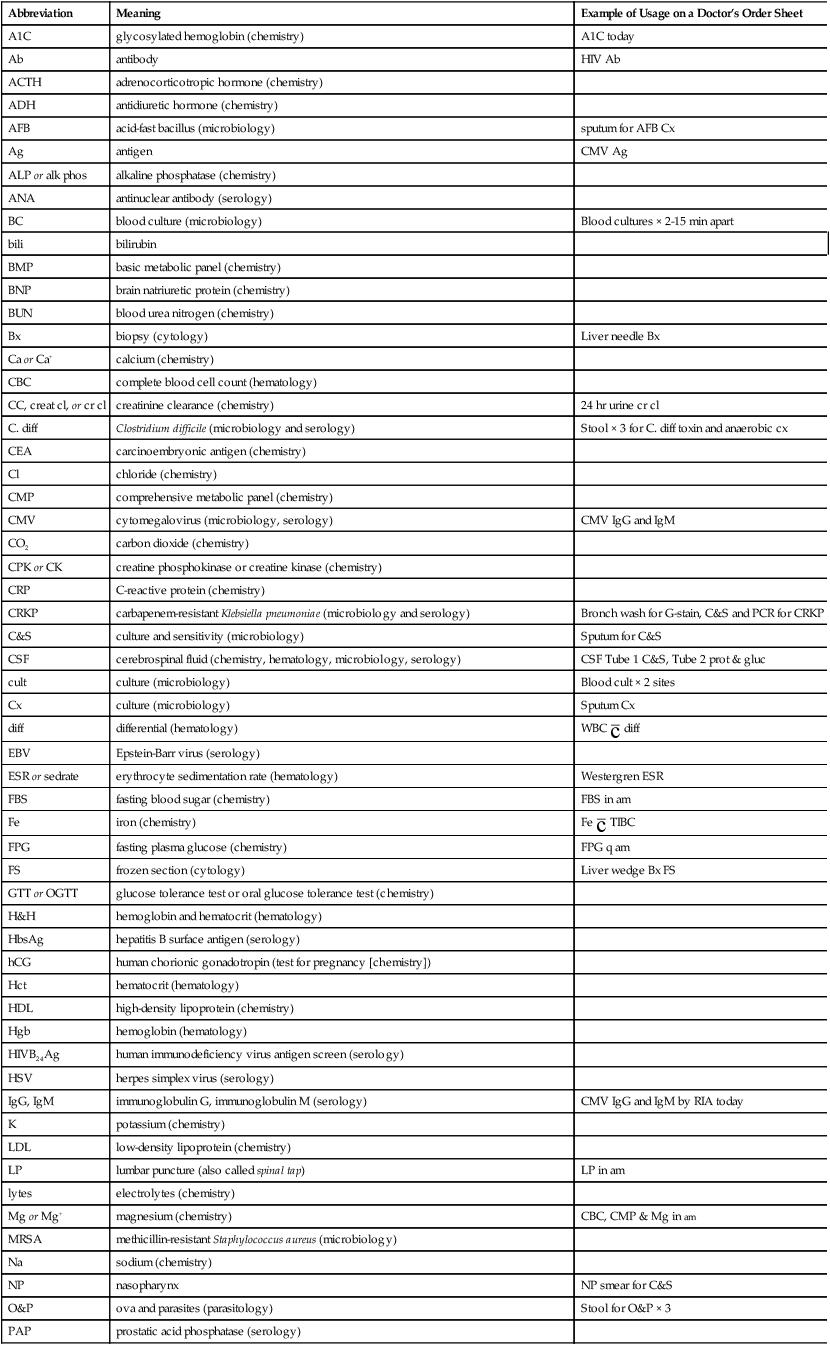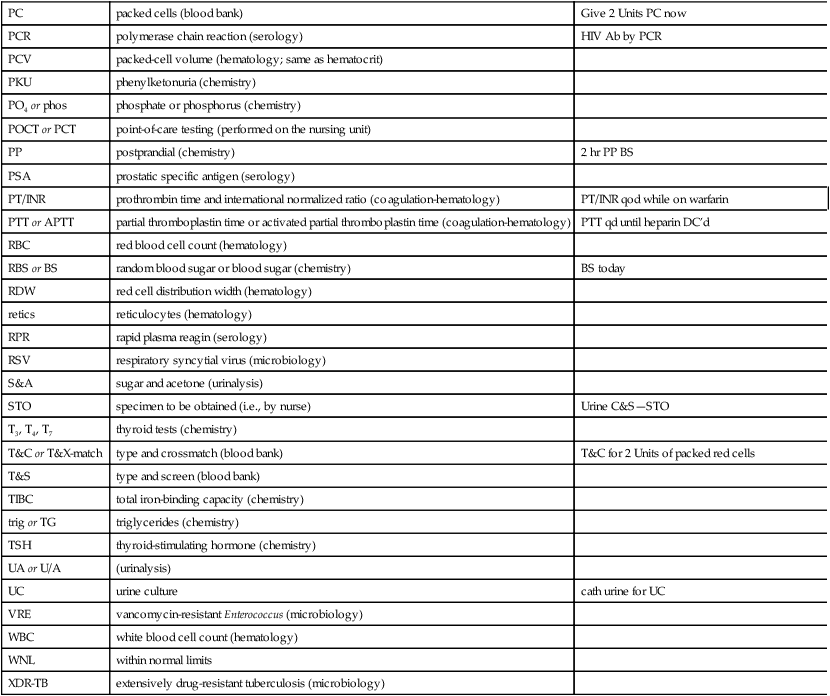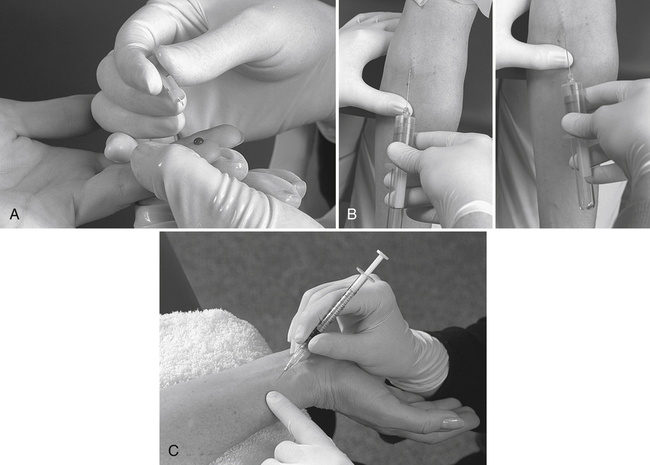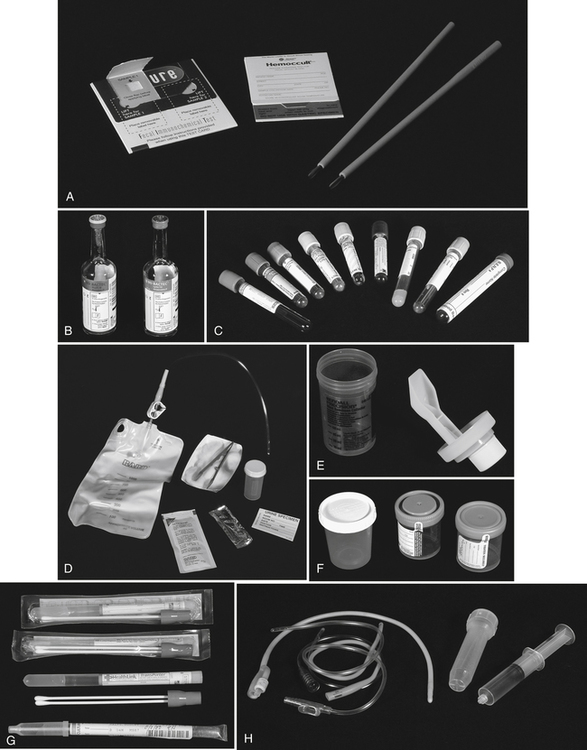On completion of this chapter, you will be able to: 1. Define the terms in the vocabulary list. 2. Write the meaning of each abbreviation in the abbreviations list. 3. List two general purposes of laboratory studies. 4. Name three major divisions and five other divisions of the laboratory. 5. Identify five specimens that may be studied in the laboratory, and list at least three specimens that would be obtained by an invasive procedure. 6. List six invasive procedures that would require a consent form signed by the patient. 7. Describe the health unit coordinator’s responsibilities in ordering laboratory tests and sending specimens to the laboratory when EMR is used and when paper charts are used and describe how routine, stat, daily, and timed studies would be ordered and performed. 8. List three tests that would be performed at the bedside (POCT) to detect occult blood in gastric and stool specimens. 9. Describe the general purpose of the hematology division of the laboratory, and list six studies that would be performed in the hematology division. 10. Describe the general purpose of the chemistry division of the laboratory. 11. Identify at least three chemistry tests that would require the patient to be fasting, and explain the difference between fasting and NPO. 12. List four tests that are included in electrolytes. 13. Describe the general purpose of the toxicology department, and explain the procedure for ordering peak and trough drug levels. 14. Describe the general purpose of the microbiology division of the laboratory, and list six studies that would be performed in the microbiology division. 15. Describe the general purpose of the serology and immunology division of the laboratory, and list three tests performed in the serology and immunology division. 16. Describe the general purpose of the blood bank, and identify the steps that must be performed to obtain blood (packed cells) for transfusion. 17. Describe the general purpose of the urinalysis division of the laboratory, and identify three methods of obtaining urine specimens. 18. Identify the procedure that would be performed to obtain pleural fluid and cerebrospinal fluid (CSF), and explain the importance of accurate labeling and appropriate transportation of these specimens. 19. Describe the purpose of the pathology division of the laboratory, and identify and describe the purpose of two subdivisions of the pathology division. 20. Describe how errors may be avoided in recording telephoned laboratory results (critical or panic values). Any substance that induces an immune response. Tissue removed from a living body for examination. Identification of the types of white cells found in the blood. The visual examination of urine using a special chemically treated stick. No solid foods by mouth and no fluids containing nourishment (e.g., sugar, milk). A procedure used to remove cerebrospinal fluid from the spinal canal. Blood that is undetectable to the eye. A surgical puncture and drainage of a body cavity. Microorganisms that cause disease. The study of body changes caused by disease. Specimens that can be collected at any time. Range of normal values for a laboratory test result. Plasma from which fibrinogen, a clotting factor, has been removed. The mucous secretion from lungs, bronchi, or trachea. A specimen that must be collected at a specific time. Identification of tissue types to predict acceptance or rejection of tissue and organ transplants. The physical, chemical, and microscopic examination of the urine. Procedure in which urine is tested and if certain parameters are met, a culture is performed. ABBREVIATIONS Tests performed by the laboratory are ordered for diagnostic purposes and for evaluation of a prescribed treatment. See the Evolve website for a comprehensive list of the studies that are performed in a laboratory. Hospital size determines the number of divisions within the laboratory and the types of tests performed in each division. For example, a large hospital may have a microbiology division with subdivisions such as bacteriology, serology and immunology, parasitology, virology, and mycology. In smaller hospitals, all the tests performed in the divisions mentioned previously may be done in the microbiology division or sent to outside laboratories. (Figure 14-1 is a laboratory divisional chart.) The divisions and some test names may vary among hospitals from those used in this book. All laboratory tests require a specimen. Blood, the most commonly used specimen, is most often obtained by nursing or laboratory personnel through venipuncture (puncture into the vein), finger stick (puncture into a capillary), or peripheral arterial or venous lines (Fig. 14-2). An additional source of blood is the umbilical cord. A “cord blood” specimen may be ordered for patients in the labor and delivery unit and is collected by nursing personnel. Other specimens for testing include urine, stool, sputum, sweat, wound drainage, discharge from body openings, and gastric washings (lavage). Nursing staff members usually collect these specimens (Fig. 14-3). The doctor usually obtains specimens by entering parts of the body or a body cavity. Types of specimens and the names of the procedures used to obtain them are listed in Table 14-1. A written consent is required to be signed by the patient before invasive procedures including any paracentesis (a surgical puncture and drainage of a body cavity), amniocentesis, lumbar puncture, or other invasive procedures listed are performed, except for pelvic examination. (Review “Preparing a Consent Form,” Chapter 8.) It may be the HUC’s responsibility to order trays, such as a lumbar puncture tray, or other equipment from the central service department (CSD) for the doctor to use to perform these procedures. TABLE 14-1 Types of Nonretrievable Specimens and Their Associated Procedures Portable automated analyzers may be used in departments that require immediate results; these decrease the need for stat specimens to be sent to the laboratory. Some tests that may be done on the unit by this method include electrolytes, blood glucose, blood urea nitrogen (BUN), hemoglobin, and hematocrit. A test to evaluate pulmonary function (see Chapter 16), called arterial blood gases (ABGs), may be run by an automated analyzer on the unit. Reagent-based tests may include a test for pregnancy or human chorionic gonadotropin (hCG) or activated clotting time (ACT), and a test for Helicobacter pylori (CLO – Campylobacter-like organism) test, a bacterium that has been indicated in ulcers of the gastrointestinal system. The CLO test actually uses a biopsy specimen obtained in the endoscopy department (see Chapter 16) and may yield positive results within 2 hours. Some of the reagent-based tests that are considered point-of-care lab tests are those that are traditionally carried out by nursing personnel; these include blood and urine monitoring for the presence of ketones and for levels of glucose. Blood glucose monitoring is discussed in Chapter 10. The D-dimer coagulation study may be done with a finger stick specimen on the unit. Guaiac, Gastroccult, or Hemoccult tests, which use reagents to detect occult blood (undetectable to the eye) in gastric and stool specimens, are considered point-of-care tests in some health care facilities.
Laboratory Orders
Note: Most doctors’ orders for laboratory tests are written on the doctors’ order sheet as the abbreviation appears here; for example, CBC is the doctor’s written order for complete blood (cell) count. Examples of doctors’ orders are given only for those orders that require more than the abbreviation.
Abbreviation
Meaning
Example of Usage on a Doctor’s Order Sheet
A1C
glycosylated hemoglobin (chemistry)
A1C today
Ab
antibody
HIV Ab
ACTH
adrenocorticotropic hormone (chemistry)
ADH
antidiuretic hormone (chemistry)
AFB
acid-fast bacillus (microbiology)
sputum for AFB Cx
Ag
antigen
CMV Ag
ALP or alk phos
alkaline phosphatase (chemistry)
ANA
antinuclear antibody (serology)
BC
blood culture (microbiology)
Blood cultures × 2-15 min apart
bili
bilirubin
BMP
basic metabolic panel (chemistry)
BNP
brain natriuretic protein (chemistry)
BUN
blood urea nitrogen (chemistry)
Bx
biopsy (cytology)
Liver needle Bx
Ca or Ca+
calcium (chemistry)
CBC
complete blood cell count (hematology)
CC, creat cl, or cr cl
creatinine clearance (chemistry)
24 hr urine cr cl
C. diff
Clostridium difficile (microbiology and serology)
Stool × 3 for C. diff toxin and anaerobic cx
CEA
carcinoembryonic antigen (chemistry)
Cl
chloride (chemistry)
CMP
comprehensive metabolic panel (chemistry)
CMV
cytomegalovirus (microbiology, serology)
CMV IgG and IgM
CO2
carbon dioxide (chemistry)
CPK or CK
creatine phosphokinase or creatine kinase (chemistry)
CRP
C-reactive protein (chemistry)
CRKP
carbapenem-resistant Klebsiella pneumoniae (microbiology and serology)
Bronch wash for G-stain, C&S and PCR for CRKP
C&S
culture and sensitivity (microbiology)
Sputum for C&S
CSF
cerebrospinal fluid (chemistry, hematology, microbiology, serology)
CSF Tube 1 C&S, Tube 2 prot & gluc
cult
culture (microbiology)
Blood cult × 2 sites
Cx
culture (microbiology)
Sputum Cx
diff
differential (hematology)
WBC  diff
diff
EBV
Epstein-Barr virus (serology)
ESR or sedrate
erythrocyte sedimentation rate (hematology)
Westergren ESR
FBS
fasting blood sugar (chemistry)
FBS in am
Fe
iron (chemistry)
Fe  TIBC
TIBC
FPG
fasting plasma glucose (chemistry)
FPG q am
FS
frozen section (cytology)
Liver wedge Bx FS
GTT or OGTT
glucose tolerance test or oral glucose tolerance test (chemistry)
H&H
hemoglobin and hematocrit (hematology)
HbsAg
hepatitis B surface antigen (serology)
hCG
human chorionic gonadotropin (test for pregnancy [chemistry])
Hct
hematocrit (hematology)
HDL
high-density lipoprotein (chemistry)
Hgb
hemoglobin (hematology)
HIVB24Ag
human immunodeficiency virus antigen screen (serology)
HSV
herpes simplex virus (serology)
IgG, IgM
immunoglobulin G, immunoglobulin M (serology)
CMV IgG and IgM by RIA today
K
potassium (chemistry)
LDL
low-density lipoprotein (chemistry)
LP
lumbar puncture (also called spinal tap)
LP in am
lytes
electrolytes (chemistry)
Mg or Mg+
magnesium (chemistry)
CBC, CMP & Mg in am
MRSA
methicillin-resistant Staphylococcus aureus (microbiology)
Na
sodium (chemistry)
NP
nasopharynx
NP smear for C&S
O&P
ova and parasites (parasitology)
Stool for O&P × 3
PAP
prostatic acid phosphatase (serology)
PC
packed cells (blood bank)
Give 2 Units PC now
PCR
polymerase chain reaction (serology)
HIV Ab by PCR
PCV
packed-cell volume (hematology; same as hematocrit)
PKU
phenylketonuria (chemistry)
PO4 or phos
phosphate or phosphorus (chemistry)
POCT or PCT
point-of-care testing (performed on the nursing unit)
PP
postprandial (chemistry)
2 hr PP BS
PSA
prostatic specific antigen (serology)
PT/INR
prothrombin time and international normalized ratio (coagulation-hematology)
PT/INR qod while on warfarin
PTT or APTT
partial thromboplastin time or activated partial thromboplastin time (coagulation-hematology)
PTT qd until heparin DC’d
RBC
red blood cell count (hematology)
RBS or BS
random blood sugar or blood sugar (chemistry)
BS today
RDW
red cell distribution width (hematology)
retics
reticulocytes (hematology)
RPR
rapid plasma reagin (serology)
RSV
respiratory syncytial virus (microbiology)
S&A
sugar and acetone (urinalysis)
STO
specimen to be obtained (i.e., by nurse)
Urine C&S—STO
T3, T4, T7
thyroid tests (chemistry)
T&C or T&X-match
type and crossmatch (blood bank)
T&C for 2 Units of packed red cells
T&S
type and screen (blood bank)
TIBC
total iron-binding capacity (chemistry)
trig or TG
triglycerides (chemistry)
TSH
thyroid-stimulating hormone (chemistry)
UA or U/A
(urinalysis)
UC
urine culture
cath urine for UC
VRE
vancomycin-resistant Enterococcus (microbiology)
WBC
white blood cell count (hematology)
WNL
within normal limits
XDR-TB
extensively drug-resistant tuberculosis (microbiology)


Introduction to Laboratory Procedures

Specimens
Specimen
Procedure Performed to Obtain Specimen
Spinal fluid
Lumbar puncture; also called spinal tap
Bone marrow
Sternal puncture; also called bone marrow biopsy
Abdominal cavity fluid
Abdominal paracentesis
Pleural fluid
Thoracentesis or thoracocentesis
Amniotic fluid
Amniocentesis
Biopsy specimen
Biopsy of a part of the body
Cervical smear
Pelvic examination
Point-of-Care Testing
![]()
Stay updated, free articles. Join our Telegram channel

Full access? Get Clinical Tree


Nurse Key
Fastest Nurse Insight Engine
Get Clinical Tree app for offline access


